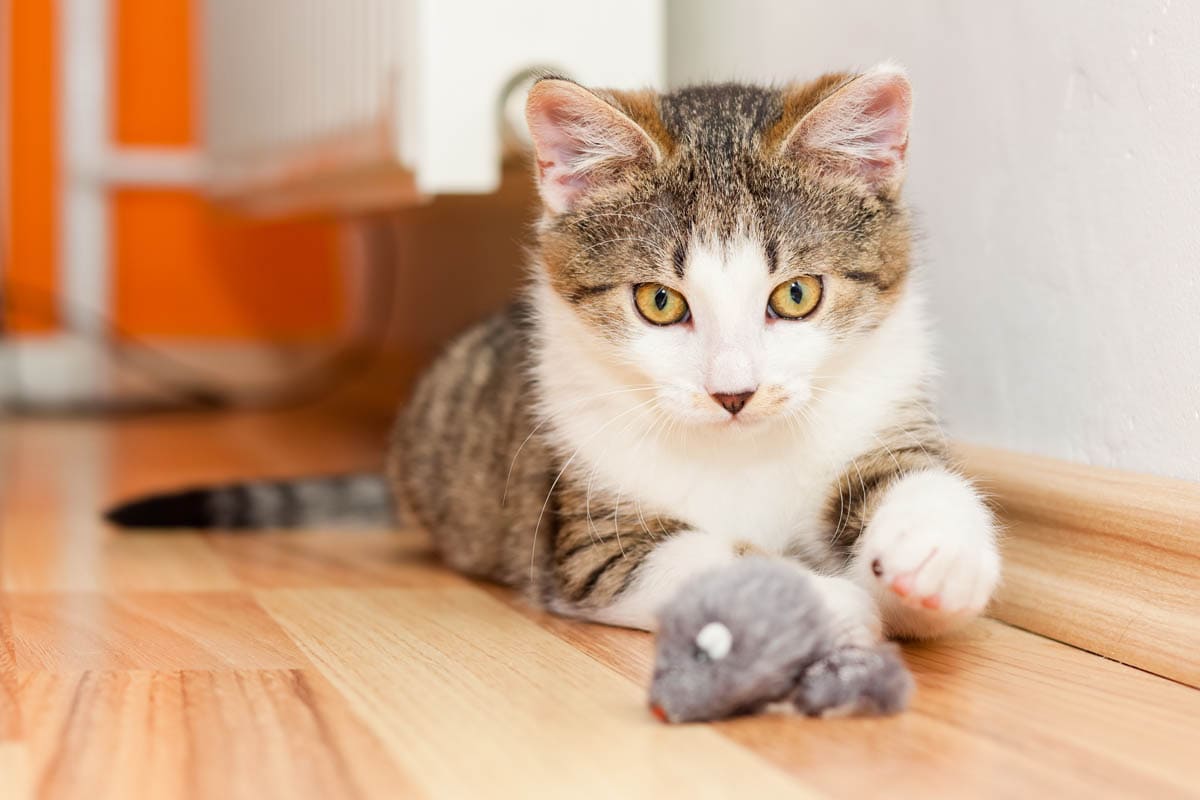Signs of boredom in cats at a glance
- Clingy behaviour
- Overeating
- Destructive behaviour
- Excessive grooming
- Going to the toilet outside the litter tray
- Fighting with other cats in the house
- Inactivity
Cats have a reputation for being independent which is what makes them attractive, especially for busy people who don’t have the time to care for a dog. But often we make the mistake of leaving them to their own devices and expect them to entertain themselves.
Boredom is on the rise as more as more pet owners make the decision to keep their cat safely indoors. Indoor cats are safe from cars, animal attacks and disease, and it is the right thing to do in most cases. Think about how a cat outside behaves; he will run, climb, scratch (strop), laze in the sun, explore, chase birds or bugs. A large number of inside are not given the same opportunities, which can lead to bored and depressed cats.
Signs of boredom in cats
Boredom can manifest in many ways which pet owners may attribute to naughty behaviour. This can lead to punishment which escalates the problem. Now you have a bored and stressed-out cat.
Destructive behaviour
Scratching the furniture, chewing plants, knocking things over are all behaviours that may indicate the cat is bored.
Excessive grooming
Cats spend between 15 to 50% of their awake time grooming themselves, which can become a compulsive behaviour in bored cats; excessive grooming can lead to areas of hair loss.
Fighting with other cats in the home
Stalking, chasing and antagonising other cats in the house.
Overeating
As with humans, cats can develop unhealthy eating habits when they are bored. This can lead to weight gain, which increases the risk of diabetes, arthritis and certain cancers.
Going to the toilet outside the tray
There are several reasons a cat may go to the toilet outside the tray which can include cystitis, urinary blockage and pain. Therefore it is important to rule out an underlying medical disorder first. Behavioural causes include dirty litter trays, inappropriate location of litter rays, inter-cat issues and boredom.
Inactivity
Loss of interest in surroundings, sleeping more, reluctance to move. Despite the fact that cats spend 15-18 hours a day sleeping and grooming, they will also have periods of activity, which can include playing, watching birds outside or following their favourite human around the house. Lack of stimulation in the home can lead to inactivity, with the cat losing interest in his or her surroundings.
Clingy behaviour
Some cats like to be around their human a lot, in-fact certain breeds are known for this and do not cope well if left for long periods on their own. However, clingy behaviour can also be a sign that the cat is bored and in need of some stimulation.
How to treat boredom in cats
Create a stimulating and enriching environment to keep boredom at bay. Indoor cats, in particular, must have plenty of opportunities to stimulate their brain as well as exercise. The key is to provide them with similar opportunities to express themselves as cats as they would have if they were outside, minus the dangers and killing of wildlife.
Daily playtime

Schedule 10-15 minutes once or twice a day to play with the cat. The goal of play therapy is to mimic the natural hunting behaviour of a cat which involves stalking, pouncing and killing the target (in this case, a wand-like cat toy).
When playing, mimic how the cat would hunt in the wild, don’t swing the toy around wildly and expect the cat to leap into the air over and over again. That is not how a prey animal behaves. Think like a mouse, run and let the cat chase, sometimes allowing him to pounce on the mouse, play dead and then move the toy if the cat releases his grip. Finish by letting the cat finally catch and kill the target, and follow up with a meal.
Have a variety of cat toys

Provide plenty of toys which include wand types, which the cat can chase, interactive cat toys, puzzles, screwed up paper and boxes or paper bags which most cats love to play in. Toys should exercise the mind as well as the body.
Don’t leave all toys out for the cat, but rotate to keep the cat interested and actively engage with the cat during play.
Laser toys can be a good warm-up but can be frustrating for cats who are never able to catch the target. When using stalking like toys, such as wands, behave as a mouse or bird would, and don’t just swing it backwards and forwards in the air. Pass the toy in front of the cat, stop, move, go under furniture and always finish the game by allowing the cat to catch and ‘kill’ the target.
Perches and cat trees

Cats love to jump, climb and be up high and feel safe if they can survey their environment or escape (toddlers and young children, dogs, strangers) by getting up high.
A multi-level cat tree, preferably near a window provides the cat with the opportunity to climb, play and watch the world go by.
Scratching posts

Cats need to claw, it helps them to shed the outer layer of the claws, and stretches the back, legs and shoulders. A scratching post will save the furniture. Look for a sturdy post that is at least 1.5 times taller than the cat.
Provide window views

Place some beds, shelves, perches or ledges positioned near windows to watch what is happening outside.
Harness train

Some cats will adapt to walking outside on a harness, the earlier you start, the easier it is. This provides the opportunity to exercise, enjoy the outside and experience new smells and surroundings. Allow the cat to stop, smell and explore. You are in control of the leash, but the cat should be able to choose which direction he or she goes in, as long as it is safe to do so.
Grow cat safe plants
 Bring the outdoors in with cat-friendly plants such as cat grass and catnip. Grow in pots or trays and rotate regularly so that they can get a chance to re-grow.
Bring the outdoors in with cat-friendly plants such as cat grass and catnip. Grow in pots or trays and rotate regularly so that they can get a chance to re-grow.
Build an outdoor cat enclosure

A safe way to give the cat outdoor access without the dangers is a cat enclosure or catio attached to the house. Plant it with cat-friendly plants, add some ramps and shelves and your cat will thank you.
Spend time with the cat

Sharing a home is a two-way deal, we don’t bring them into the home and then ignore them. A cat’s need for human interaction varies but almost all cats like to be a part of the family. That includes talking to them, playing with them, and physical attention in the form of grooming, stroking and cuddling. Don’t force attention on a cat who would rather his own company, but if the cat seeks you out, don’t push him away.

